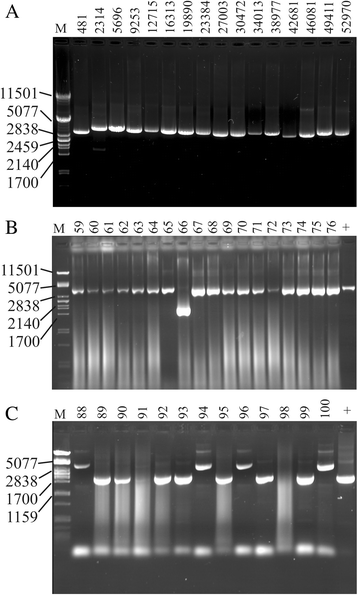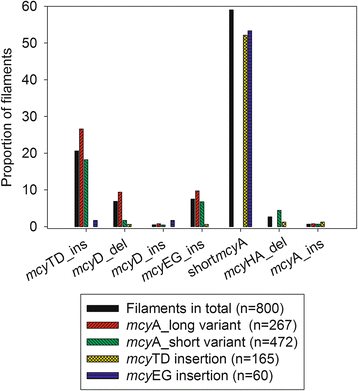Emergence of nontoxic mutants as revealed by single filament analysis in bloom-forming cyanobacteria of the genus Planktothrix
- PMID: 26911978
- PMCID: PMC4766695
- DOI: 10.1186/s12866-016-0639-1
Emergence of nontoxic mutants as revealed by single filament analysis in bloom-forming cyanobacteria of the genus Planktothrix
Abstract
Background: Bloom-forming cyanobacteria cause toxic algae outbreaks in lakes and reservoirs. We aimed to explore and quantify mutation events occurring within the large mcy gene cluster (55 kbp) encoding microcystin (MC) biosynthesis that inactivate MC net production. For this purpose we developed a workflow to detect mutations in situ occurring anywhere within the large mcy gene cluster as amplified from one single filament of the red-pigmented cyanobacterium Planktothrix rubescens. From five lakes of the Alps eight hundred Planktothrix filaments were isolated and each individual filament was analyzed for mutations affecting the mcy genes.
Results: Mutations inactivating MC synthesis were either through an insertion element ISPlr1 or the partial deletion of mcy genes. Neutral mutations not affecting MC biosynthesis occurred within two intergenic spacer regions, either through the insertion of a Holliday-junction resolvase RusA or ISPlr1. Altogether, the insertions affected a few mcy genes only and their location was correlated with regions similar to repetitive extragenic palindromic DNA sequences (REPs). Taking all of the filaments together, the mutations leading to the inactivation of MC synthesis were more rare (0.5-6.9%), when compared with the neutral mutations (7.5-20.6%). On a spatial-temporal scale the ratio of MC synthesis-inactivating vs. neutral mutations was variable, e.g., the filament abundance carrying partial deletion of mcyD (5.2-19.4%) and/or mcyHA (0-7.3%) exceeded the abundance of neutral mutations.
Conclusions: It is concluded that insertion events occurring within the Planktothrix mcy gene cluster are predictable due to their correlation with REPs. The frequency of occurrence of the REPs within the mcy gene cluster of Planktothrix relates to the rather common mutation of mcy genes in Planktothrix. Spatial-temporal variable conditions may favor the emergence of partial mcy deletion mutants in Planktothrix, in particular a higher proportion of genotypes resulting in inactivation of MC synthesis might be caused by increased ISPlr1 activity.
Figures




Similar articles
-
Role of toxic and bioactive secondary metabolites in colonization and bloom formation by filamentous cyanobacteria Planktothrix.Harmful Algae. 2016 Apr;54:69-86. doi: 10.1016/j.hal.2016.01.004. Epub 2016 May 12. Harmful Algae. 2016. PMID: 27307781 Free PMC article. Review.
-
Distribution and abundance of nontoxic mutants of cyanobacteria in lakes of the Alps.Microb Ecol. 2009 Aug;58(2):323-33. doi: 10.1007/s00248-009-9484-1. Epub 2009 Feb 13. Microb Ecol. 2009. PMID: 19214623 Free PMC article.
-
Transposons inactivate biosynthesis of the nonribosomal peptide microcystin in naturally occurring Planktothrix spp.Appl Environ Microbiol. 2006 Jan;72(1):117-23. doi: 10.1128/AEM.72.1.117-123.2006. Appl Environ Microbiol. 2006. PMID: 16391033 Free PMC article.
-
Predicting blooms of toxic cyanobacteria in eutrophic lakes with diverse cyanobacterial communities.Sci Rep. 2017 Aug 21;7(1):8342. doi: 10.1038/s41598-017-08701-8. Sci Rep. 2017. PMID: 28827675 Free PMC article.
-
The biological functions of microcystins.Water Res. 2024 Sep 15;262:122119. doi: 10.1016/j.watres.2024.122119. Epub 2024 Jul 18. Water Res. 2024. PMID: 39059200 Review.
Cited by
-
Role of toxic and bioactive secondary metabolites in colonization and bloom formation by filamentous cyanobacteria Planktothrix.Harmful Algae. 2016 Apr;54:69-86. doi: 10.1016/j.hal.2016.01.004. Epub 2016 May 12. Harmful Algae. 2016. PMID: 27307781 Free PMC article. Review.
-
Toxic/Bioactive Peptide Synthesis Genes Rearranged by Insertion Sequence Elements Among the Bloom-Forming Cyanobacteria Planktothrix.Front Microbiol. 2022 Jul 28;13:901762. doi: 10.3389/fmicb.2022.901762. eCollection 2022. Front Microbiol. 2022. PMID: 35966708 Free PMC article.
-
Chemically labeled toxins or bioactive peptides show a heterogeneous intracellular distribution and low spatial overlap with autofluorescence in bloom-forming cyanobacteria.Sci Rep. 2020 Feb 17;10(1):2781. doi: 10.1038/s41598-020-59381-w. Sci Rep. 2020. PMID: 32066776 Free PMC article.
-
Cyanotoxin-encoding genes as powerful predictors of cyanotoxin production during harmful cyanobacterial blooms in an inland freshwater lake: Evaluating a novel early-warning system.Sci Total Environ. 2022 Jul 15;830:154568. doi: 10.1016/j.scitotenv.2022.154568. Epub 2022 Mar 14. Sci Total Environ. 2022. PMID: 35302035 Free PMC article.
-
Single colony genetic analysis of epilithic stream algae of the genus Chamaesiphon spp.Hydrobiologia. 2018 Apr;811(1):61-75. doi: 10.1007/s10750-017-3295-z. Epub 2017 Aug 21. Hydrobiologia. 2018. PMID: 29556110 Free PMC article.
References
-
- WHO: Guidelines for drinking-water quality. First addendum to third edition. 3rd edition, vol. 1, recommendations. Geneva, Switzerland: World Health Organization; 2006:515.
-
- Almodovar A, Nicola GG, Nuevo M. Effects of a bloom of Planktothrix rubescens on the fish community of a Spanish reservoir. Limnetica. 2004;23(1–2):167–78.
-
- Paulino S, Valerio E, Faria N, Fastner J, Welker M, Tenreiro R, et al. Detection of Planktothrix rubescens (Cyanobacteria) associated with microcystin production in a freshwater reservoir. Hydrobiologia. 2009;621(1):207–11. doi: 10.1007/s10750-008-9640-5. - DOI
-
- Padisák J, Vasas G, Borics G. Phycogeography of freshwater phytoplankton: traditional knowledge and new molecular tools. Hydrobiologia. 2016;764(1):3–27. doi: 10.1007/s10750-015-2259-4. - DOI
Publication types
MeSH terms
Substances
Grants and funding
LinkOut - more resources
Full Text Sources
Other Literature Sources

